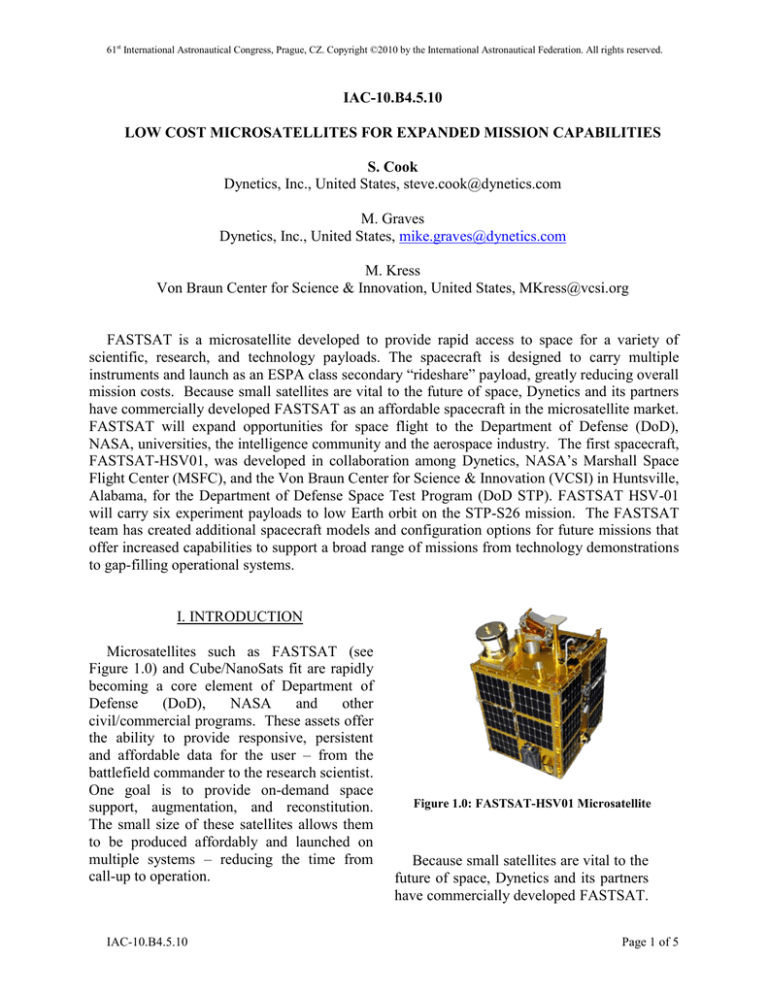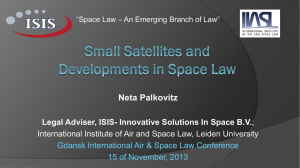
61st International Astronautical Congress, Prague, CZ. Copyright ©2010 by the International Astronautical Federation. All rights reserved.
IAC-10.B4.5.10
LOW COST MICROSATELLITES FOR EXPANDED MISSION CAPABILITIES
S. Cook
Dynetics, Inc., United States, steve.cook@dynetics.com
M. Graves
Dynetics, Inc., United States, mike.graves@dynetics.com
M. Kress
Von Braun Center for Science & Innovation, United States, MKress@vcsi.org
FASTSAT is a microsatellite developed to provide rapid access to space for a variety of
scientific, research, and technology payloads. The spacecraft is designed to carry multiple
instruments and launch as an ESPA class secondary “rideshare” payload, greatly reducing overall
mission costs. Because small satellites are vital to the future of space, Dynetics and its partners
have commercially developed FASTSAT as an affordable spacecraft in the microsatellite market.
FASTSAT will expand opportunities for space flight to the Department of Defense (DoD),
NASA, universities, the intelligence community and the aerospace industry. The first spacecraft,
FASTSAT-HSV01, was developed in collaboration among Dynetics, NASA’s Marshall Space
Flight Center (MSFC), and the Von Braun Center for Science & Innovation (VCSI) in Huntsville,
Alabama, for the Department of Defense Space Test Program (DoD STP). FASTSAT HSV-01
will carry six experiment payloads to low Earth orbit on the STP-S26 mission. The FASTSAT
team has created additional spacecraft models and configuration options for future missions that
offer increased capabilities to support a broad range of missions from technology demonstrations
to gap-filling operational systems.
I. INTRODUCTION
Microsatellites such as FASTSAT (see
Figure 1.0) and Cube/NanoSats fit are rapidly
becoming a core element of Department of
Defense
(DoD),
NASA
and
other
civil/commercial programs. These assets offer
the ability to provide responsive, persistent
and affordable data for the user – from the
battlefield commander to the research scientist.
One goal is to provide on-demand space
support, augmentation, and reconstitution.
The small size of these satellites allows them
to be produced affordably and launched on
multiple systems – reducing the time from
call-up to operation.
IAC-10.B4.5.10
Figure 1.0: FASTSAT-HSV01 Microsatellite
Because small satellites are vital to the
future of space, Dynetics and its partners
have commercially developed FASTSAT.
Page 1 of 5
61st International Astronautical Congress, Prague, CZ. Copyright ©2010 by the International Astronautical Federation. All rights reserved.
The first FASTSAT spacecraft (FASTSATHSV01) was managed by NASA’s Marshall
Space Flight Center (MSFC) and developed in
collaboration with Dynetics and the Von
Braun Center for Science & Innovation
(VCSI) in Huntsville, Alabama.
The FASTSAT bus enables a broad range
or missions for a fraction of the cost and
schedule of other options. Future missions
include:
Space Tests and Experiments
Technology Demonstrations
Rapid Response Gap Filler
Augmenting Large Systems
CubeSat Constellation Deployment
Earth and Atmospheric Observation
Space Weather
Intelligence, Surveillance, and
Reconnaissance
The FASTSAT project leverages the deep
base of space systems development expertise
in Huntsville, an innovative business model
through VCSI, and Dynetics’ advanced
engineering, rapid product development, and
manufacturing capabilities. The team executes
rapid development processes while applying
the rigors for engineering excellence, safety,
mission assurance, and manufacturing quality.
FASTSAT has been designed from the ground
up to meet short schedules with modular
components and configurable layouts to enable
a broad range of payloads at a lower cost and
shorter timeline than scaling down more
complex spacecraft.
This approach gives the FASTSAT team
(Dynetics, MSFC, & VCSI) the ability to
rapidly take the spacecraft from design to
launch readiness in 12 to 18 months,
dependent on options, enhancing affordability
and responsiveness.
IAC-10.B4.5.10
II. MARKET PROJECTIONS
Market elasticity appears to be high for
microsatellites. According to the Federal
Aviation Administration’s (FAA) recent
report, “Launch rates may increase beyond
forecasted levels if a new microsatellite launch
capability emerges…. The emergence of a
micro-satellite
launch
vehicle,
with
competitive launch costs, may cause
microsatellite payloads to shift from the multimanifest approach to individual launch on
these new vehicles. This would result in a
larger number of launches.”1
As can be seen in Figure 2.0, the FAA
predicts 262 Low Earth Orbit (LEO) satellites
will be required over the next decade. If
history is a guide, approximately 25% of these
will be in the microsatellite class (<200 kg).1
Figure 2.0 FAA LEO Satellite Projections
There are similar signs and trends in the
U.S. government market:
– NASA Small Satellite Missions:
o Franklin/Edison
Small
Satellite
Demonstration Program
o Venture Class Earth Science Missions
– Continued DoD Push for Small Satellites:
“Deputy Secretary of Defense William
Lynn…indicated that the responsive space
concept will be a major part of the
document…..can help us counter threats to
Page 2 of 5
61st International Astronautical Congress, Prague, CZ. Copyright ©2010 by the International Astronautical Federation. All rights reserved.
our space capabilities. By building systems
on small satellites, using modular
components,
ORS
[Operationally
Responsive Space] gives us the ability to
rapidly augment our space systems.”2
III. FASTSAT HSV-01
Aboard STP-S26, FASTSAT-HSV01 will
be flying a total of six instruments approved
by the U.S. Department of Defense (DoD)
Space Experiments Review Board. STP-S26 is
executed by the DoD Space Test Program
(STP) at the Space Development and Test
Wing (SDTW), Kirtland Air Force Base,
N.M., which is a unit of the Air Force Space
and Missile Systems Center.
FASTSAT HSV-01 was developed using
commercial funding from Dynetics and a
unique public-private partnership with the
NASA Marshall Space Flight Center, through
the VCSI. FASTSAT rapidly moved through
development – going from ATP to
environmental test in 10 months and then to
ready-for-flight in another 5 months. The bus
underwent a rigorous development and test
process and was certified to both USAF and
NASA standards, receiving a NASA
Certificate of Flight Readiness.
Analyzer (PISA), and Miniature Imager for
Neutral
Ionospheric
atoms
and
Magnetospheric Electrons (MINI-ME). TTI’s
objective is to increase the orbit propagation
accuracy of LEO assets during solar and
geomagnetic storms by remotely measuring
thermospheric temperature and atmospheric
atomic oxygen. PISA measures resonance
frequencies which depend on electron density,
temperature, and magnetic field strength.
Finally,
MINI-ME
remotely
senses
magnetospheric plasma to improve space
weather forecasting.
Figure 3.0 NanoSail-D After Deployment
from FASTSAT
IV. FUTURE MISSION CAPABILITY
FASTSAT-HSV01 carries a record six
SERB experiments on one bus: three
technology demonstrations, and three NASA
atmospheric research experiments. The
technology demonstrations
are Threat
Detection
System
(TDS),
NanoSail
Demonstration (NanoSail-D), and a Miniature
Star Tracker (MST). TDS is space-qualifying
advanced technology. NanoSail-D is a free
flying solar sail that will deploy from a P/POD
built into the satellite after FASTSAT has
separated from the launch vehicle (See Figure
3.0). The NASA atmospheric research
experiments are Thermospheric Temperature
Imager (TTI), Plasma Impedance Spectrum
IAC-10.B4.5.10
The FASTSAT team has created additional
spacecraft models and configuration options
for future missions that offer increased
capabilities to support a broad range of
missions from technology demonstrations to
gap-filling operational systems. As shown in
Table 1.0, these include the A-110, 210, 210M and B210 bus families. The A-110 bus
provides basic payload services and is fully
ESPA compliant. The A-210 model adds
more precise attitude control and the B-210
model further adds a 150W+ power upgrade.
While intended to be a standardized bus,
Page 3 of 5
61st International Astronautical Congress, Prague, CZ. Copyright ©2010 by the International Astronautical Federation. All rights reserved.
Dynetics has explored other growth options
including large deployables.
One capability unique to the FASTSAT
microsatellite is the ability to deploy CubeSats
from orbit, on-demand as depicted in Figure
5.0. A 1st generation capability will be
demonstrated on the STP-S26 mission with the
deployment of NanoSail-D.
As the
acceptability of microsatellites evolves, the
need to deploy constellations of microsatellites
flying in formation is receiving greater
recognition. Such missions include ISR, Space
Weather and Earth Observation. To execute
these missions, Dynetics and VCSI have
secured funding and are planning to design a
multi-cubesat deployer that can be integrated
into the FASTSAT bus in collaboration with
MSFC and Ames Research Center. Such a
concept is illustrated in Figure 5.0 with the
A210-M bus, which can deploy up to 4, 3U
CubeSats. This initiative capitalizes on
existing deployer technology and reengineers
it to provide users with a new capability to
strategically emplace CubeSats or store them
on orbit for future on-demand deployment.
Such a capability offers several “firsts,”
including:
On-orbit charging, health & status of
CubeSats
Ability to protect CubeSats from the space
radiation environment
Launch on-demand of 6-8 CubeSats
Constellation deployment and
communication
Test a potential conop: the element of
surprise to an enemy tracking our actions
Optional video of deployment
Late integration – secondary payload
IAC-10.B4.5.10
Figure 5.0 Multi-Cubesat
Deployment
The rapid delivery of CubeSat constellations
from the FASTSAT microsatellite provides a
responsive, persistent and affordable data to
the user.
V. CONCLUSION
Microsatellites such as FASTSAT and
Cube/NanoSats fit are rapidly becoming a core
element of Department of Defense (DoD),
NASA and other civil/commercial programs.
These assets offer the ability to provide
responsive, persistent and affordable data for
the user – from the battlefield commander to
the research scientist. The goal is to provide
on-demand space support, augmentation, and
reconstitution.
The small size of these
satellites allows them to be produced
affordably and launched on multiple systems –
reducing the time from call-up to operation.
The FASTSAT bus enables a broad range
or missions for a fraction of the cost and
schedule of other options.
Page 4 of 5
61st International Astronautical Congress, Prague, CZ. Copyright ©2010 by the International Astronautical Federation. All rights reserved.
Table 1.0 FASTSAT Standardized Bus Options
1
2
Commercial Space Transportation Forecasts, 2010, Federal Aviation Administration
Small Satellites, July 2010, National Defense Industries Association Magazine
IAC-10.B4.5.10
Page 5 of 5


